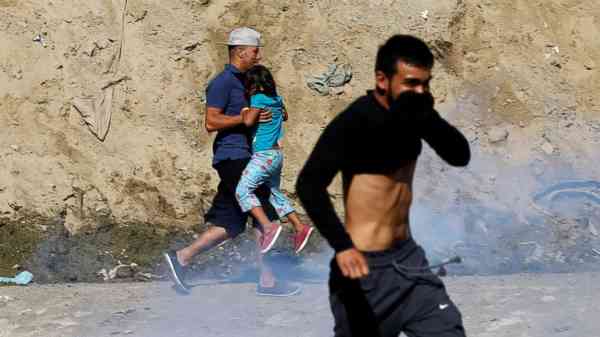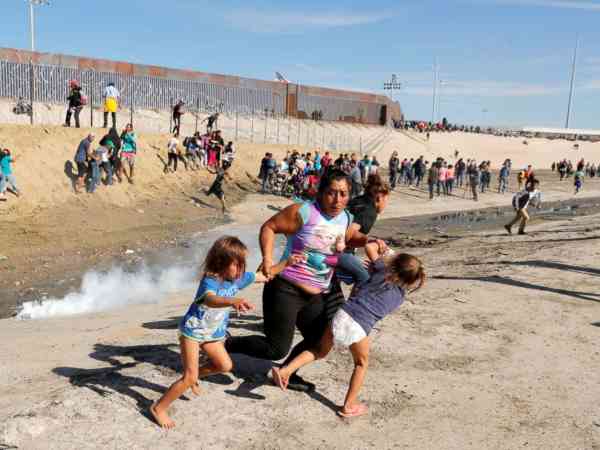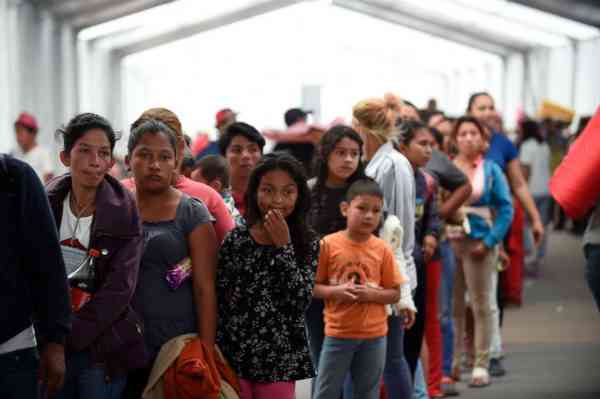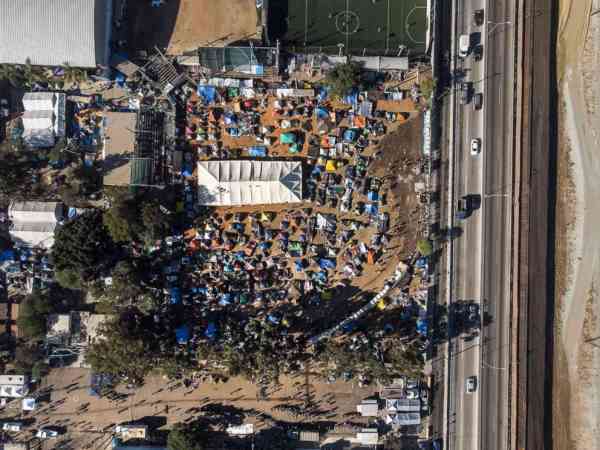
Tear gas is legal. The question is whether it was appropriate.
The U.S. has the legal right to defend its borders, including the use of tear gas. The U.S. also has the right to decide who can enter. Human smuggling, drug trafficking, and gang activity are all concerns. And in a recent Supreme Court ruling, the court sided with President Donald Trump on a travel ban by noting in part that the law gives the executive branch broad authority when deciding who can cross its borders.
(MORE: Supreme Court upholds Trump’s travel ban)
Enter the caravan of migrants mostly from El Salvador, Guatemala and Honduras gathered at the border crossing linking San Diego, California and Tijuana, Mexico.
The Trump administration said its decision to use tear gas last weekend was made only after “multiple instances” of migrants throwing rocks at border personnel and trying to breach the fence. The current policy of the U.S. Customs and Border Protection Agency says any use of “less-lethal force must be both objectively reasonable and necessary” to carry out an officer’s law enforcement duties.
However, according to CBP policy, agents are not allowed to use tear gas on pregnant women and children. And one former senior official at the Homeland Security Department is raising questions about whether the use of tear gas violated that policy.
John Cohen, a former acting under secretary at DHS and an ABC News contributor, said the Obama administration used tear gas at the border but it was only allowed as a defensive measure. Cohen also notes the part of the CBP handbook that says officials should consider other force options when it comes to particularly vulnerable people.
A photo taken by Reuters on Sunday appears to show a mother on the Mexican side of the border fleeing the tear gas with her children.

Kim Kyung-Hoon/ReutersMaria Meza runs away from tear gas with her five-year-old twin daughters Saira Mejia Meza, left, and Cheili Mejia Meza in front of the border wall between the U.S. and Mexico, in Tijuana, Nov. 25, 2018.
“There’s a serious question as to whether shooting a projectile into Mexico and having the projectile land in an area that includes the elderly and children is an appropriate use of force,” said Cohen.
The American Civil Liberties Union went further, calling the use of tear gas an “inhumane” overuse of force that was part of Trump’s “obsessive, racist crusade against immigrants.”
The White House, DHS and CBP have each pushed back against the criticisms.
“No one wants women or children or any individuals to have this happen, which is why we’ve encouraged them to follow the law and go to ports of entry,” said White House press secretary Sarah Sanders.
A CBP spokesman said Thursday that no criminal charges would be filed against the 42 migrants arrested during the Sunday incident. But the migrants arrested will face administrative removal proceedings and a likely long-term detention by Immigration and Customs Enforcement.
According to the Migration Policy Institute,a nonpartisan center that analyzes immigration trends, most people arrested by CBP for crossing illegally are not criminally prosecuted.
Why asylum?
Just as the U.S. has the right to defend its border, people have a right under U.S. and international law to seek asylum if they fear persecution in their home country on the grounds of race, religion, nationality, membership in a particular social group or political opinion. If a person makes an asylum claim, they undergo a “credible fear interview” with an officer at the U.S. Citizenship and Immigration Services who is trained in fraud detection, national security and the conditions of certain countries.

Alfredo Estrella/AFP/Getty ImagesCentral American migrants taking part in a caravan heading to the US, line up to borrow a sleeping pad, after arriving at a temporary shelter, set up in a stadium in Mexico City, Nov. 5, 2018.
The Migration Policy Institute confirms that asylum claims have been on the rise. Credible fear claims jumped from 9,000 in 2010 to 79,000 in 2017. The group also notes that more migrants are bringing children with them. It used to be 1 in 10 border crossers traveled with a child, it’s now 1 in 3.
What divides most Americans, however, is why and whether those claims are legitimate.
Trump has claimed that the uptick in children at the border is because unscrupulous migrants are looking for leverage in immigration proceedings. He says people traveling with their children are what he termed “grabbers,” suggesting without evidence that many parents and children aren’t related.
The Migration Policy Institute attributes the influx of children at the border primarily to the extreme violence families are facing in Central America.
Homeland Security Secretary Kirstjen Nielsen this week noted that fewer than 10 percent of asylum applicants from those three Central American countries wind up with their requests approved and suggested that 90 percent of those waiting at the border are ineligible.
While that figure includes both applications of new arrivals and those already in the country, her claim does not address other avenues people pursue to live in the U.S. It’s possible to submit an asylum application while going through another process, including a visa application for victims of human trafficking.
Susan Long, a statistician at Syracuse University who specializes in analyzing raw-form immigration data, says Nielsen’s claim on face value is not accurate.
“It’s kind of misleading to imply these individuals weren’t successful in having a judge find they were entitled to remain in the United States,” Long told ABC News. “This 10 percent number is nonsense.”

SLIDESHOW: Slideshow: Migrant caravans journey to the U.S. border
What are Trump’s options?
The question now seems to be whether patience will work for the crowds of people still hoping to process an asylum claim at a U.S. checkpoint or if more clashes are inevitable. CBP officials said this week it could take as long as two months before they can even start processing claims from people in the caravan given the backlog that existed before they arrived.
According to The Associated Press, U.S. officials are processing fewer than 100 claims a day with a waiting list already with some 3,000 people on it. And Mexico’s incoming government has denied reports that it plans to allow asylum-seekers to wait in the country while their claims move through U.S. immigration courts, putting it at odds with what the Trump administration wants.
(MORE: Incoming Mexico gov’t: No deal to host US asylum-seekers)
Cohen said he believes some of the migrants tried to breach the border because they are frustrated and desperate. U.S. authorities have estimated that several thousand migrants are camped in Tijuana, many inside a sports complex under difficult conditions. The former acting under secretary at DHS said the administration, which knew several weeks ahead of the caravan’s arrival, should be working with the Mexican government to identify and immediately deport any known criminals, then use the extra resources to expedite asylum requests.
The White House will get that chance Saturday when a U.S. delegation, including Vice President Mike Pence, arrives in Mexico for the inauguration of its new president.
“Your goal should be to address the situation — not to let it fester until it escalates into a violent confrontation,” Cohen said.
Sourse: abcnews.go.com
0.00 (0%) 0 votes


































